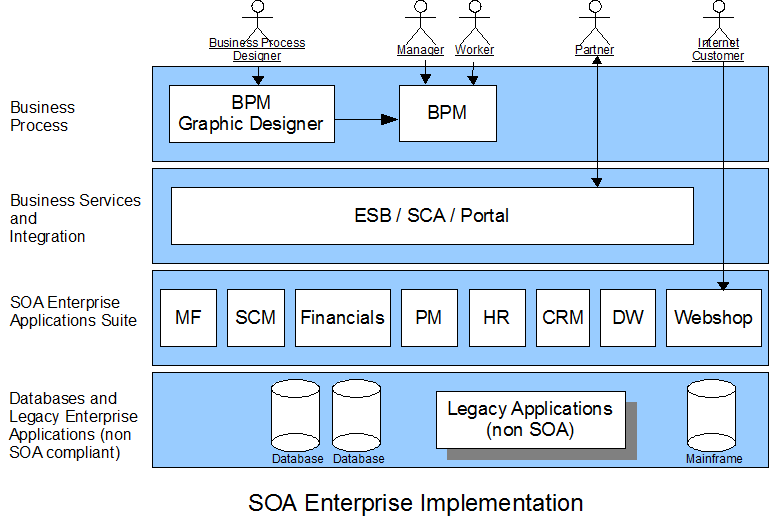Difference between revisions of "BPM Integration"
m |
|||
| Line 16: | Line 16: | ||
'''Legend:''' | '''Legend:''' | ||
| − | |||
;BPM: Business Process Management | ;BPM: Business Process Management | ||
;ESB: Enterprise Service Bus | ;ESB: Enterprise Service Bus | ||
| Line 33: | Line 32: | ||
* automated steps - Enterprise Applications colaborate to execute the particular function | * automated steps - Enterprise Applications colaborate to execute the particular function | ||
| − | The Business Process Designers use a BPM Graphic Design tool to describe the process. | + | The Business Process Designers use a BPM Graphic Design tool to describe the process. The process is described in BPM Graphic Notation (BPMN). |
| + | |||
| + | === Business Services and Integration === | ||
| + | This is the integration layer that performs the following functions: | ||
| + | * services aggregation and presentation | ||
| + | * data transformation | ||
| + | * protocol mediation | ||
| + | * implements non-functional requirements such as security, quality of service monitoring ... | ||
| + | This layer functionality is mostly provided by off-the-shelf products with small amounts of Java code. | ||
| + | |||
| + | === SOA Enterprise Applications Suite === | ||
| + | |||
| + | All SOA compliant business applications are included in this layer. These applications are orchestrated by BPM to deliver functionally for end-to-end processes. | ||
| + | |||
| + | === Databases and Legacy Applications === | ||
| + | |||
| + | Databases and SOA non compliant business applications belong to this layer. Special adaptors could be implemented in Integration Layer to facilitate communication with Legacy Applications. | ||
| + | |||
| + | === Opentaps 2.0 === | ||
| + | If we believe that SOA will dominate the Enterprise Software landscape then it makes sense to turn Opentaps in a Suite of SOA Enterprise Applications. | ||
| + | |||
| + | Benefits: | ||
| + | * smaller independent applications with separate life cycles are easier to development and maintenan | ||
| + | * applications can be matched and mixed opening the option to integrate easier with third party | ||
Revision as of 09:04, 6 May 2009
Business Process Management (BPM) is probably the killer Enterprise Application as email was the killer Internet Application. Every business small or large has a business process however in most cases it is informal and business process automation is fragmented across many Enterprise Applications. As email revolutionised the way we communicate toady I expect BPM to revolutionise the way workers, managers and partners cooperate in the Enterprise.
Contents
BPM and SOA
A good explanation of Service Oriented Layered Architecture (SOA) is provided by Object Management Group (OMG) here (a local copy is here)
In a nutshell:
- Business Process Layer exposes IT systems functionality to business users and business process designers
- Business Services is the Enterprise Integration (EI) Layer for Enterprise Applications (Components)
- Components Layer is the Enterprise Applications Suite
- Operational Resources Layer are the Databases and Legacy Enterprise Systems
SOA Enterprise Implementation
Legend:
- BPM
- Business Process Management
- ESB
- Enterprise Service Bus
- SCA
- Service Component Architecture
- MF
- Manufacturing
- SCM
- Supply Chain Management
- PM
- Project Management
- HR
- Human Resources
- CRM
- Customer Relationship Management
- DW
- Data Warehouse
Business Process
Workers and Managers use the BPM application to execute the business processes. BPM includes:
- manual steps - the business user interacts with the system
- automated steps - Enterprise Applications colaborate to execute the particular function
The Business Process Designers use a BPM Graphic Design tool to describe the process. The process is described in BPM Graphic Notation (BPMN).
Business Services and Integration
This is the integration layer that performs the following functions:
- services aggregation and presentation
- data transformation
- protocol mediation
- implements non-functional requirements such as security, quality of service monitoring ...
This layer functionality is mostly provided by off-the-shelf products with small amounts of Java code.
SOA Enterprise Applications Suite
All SOA compliant business applications are included in this layer. These applications are orchestrated by BPM to deliver functionally for end-to-end processes.
Databases and Legacy Applications
Databases and SOA non compliant business applications belong to this layer. Special adaptors could be implemented in Integration Layer to facilitate communication with Legacy Applications.
Opentaps 2.0
If we believe that SOA will dominate the Enterprise Software landscape then it makes sense to turn Opentaps in a Suite of SOA Enterprise Applications.
Benefits:
- smaller independent applications with separate life cycles are easier to development and maintenan
- applications can be matched and mixed opening the option to integrate easier with third party

